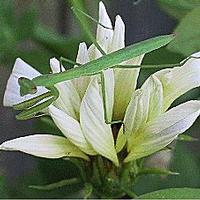The Praying Mantis perhaps more than all other insects incites our affection and imagination. Their triangular space age head somehow connotes awareness, inquisitiveness, even intelligence. Maybe we see ourselves in them. Maybe they signify what we would imagine the apex of human awareness to be: stillness and quiet, clear, thoughtful, self-controlled, and yet completely integrated into the sensual world.
The mythologies surrounding Mantodea are as interesting as its biology and social structure. And surely, once you experience their presence in your own backyard garden, strange and wonderful affections will emerge, stories will be told and memories will linger about the mighty Mantis.
Living Pest Control
If you are lucky enough to have Mantids live in your garden, you will most likely get the chance to see them catch wasps and flies in mid-air.
In the wilds of the garden the Mantis is a highly skilled, calculating, beneficial hunter, a large carnivorous predator who specializes in catching and devouring its prey alive. This amazing insect can easily reach six inches in length. It can move its head 180 degrees. It can see objects 30 feet away. It has ultrasonic hearing that can detect the sound of flying bats. It changes color to suit the terrain. It will eat hundreds, perhaps thousands of garden pests during its short life. As such, they are perfect garden companions, ridding your land of unwanted pests like the yellow wasp and common house fly. The Mantid tends to be indiscriminate in its choice of prey. Unfortunately, they will eat Honeybees, too, if they get the chance. And famously, they will eat each other if they're hungry and in the mood for a snack (although there are theoretical claims that cannibalistic behavior among Mantids is mostly a result of captivity and/or artificial living conditions).
You Can Buy Praying Mantis Egg Pods
You can buy thee egg cases (called "ootheca") for a short time mid to late spring, just when the air begins to warm up during the day and the humidity is just right. That is, a week or so before the pods are ready to hatch.
Giant Praying Mantis Eats A Bird
Not quite a Bald Eagle, but read this amazing story about a large Praying Mantis in Pennsylvania who skewered a Hummingbird in mid air, then proceeded to eat it.
The Mantids are known for being overly brave when it comes to attacking others, often attacking creatures as large and larger than themselves. They are not known to attack humans, but instead will sometimes tolerate being held. Their bravery has inspired poets and philosophers for centuries.
Simply place the papery pods in a warm, dry place in or near your garden and soon the baby Mantis nymphs will appear. The nymphs look exactly like the adult Mantis, only very tiny, about 3/8ths inch. Each pod can hold as many as 200 or so. If hatched in the outdoors, they immediately begin to disperse. They need to disperse, lest they eat each other up. Once dispersed, they become territorial and solitary. During the warm summer months, the Mantises keep to themselves. They eat, grow, set out a territory, hunt, molt and when mating season arrives, sex for the male Mantis becomes a way of dying early, as the female likes to feed upon the male's body during copulation. Before autumn frost, the female produces, then attaches the egg pods to branches not too far but well away from the ground.
According to University of Arizona's Center for Insect Science Education Outreach, the Praying Mantis has highly developed eyes and optic nerves that enable them to see images and even color. This means they can see you (so, if you were a bug you'd be lunch!). And, there are no known negative environmental effects from their presence. Both native and exotic species coexist with open field studies reporting the entire population either stable or on the rise.
If you're interested in hatching a pod in your yard, it's definitely worth it. Buy the pod in April or May. What more delightful way to teach your children about the unimaginable cruelty of nature.
Does the Praying Mantis Actually Pray?
Only when sitting on flowers. Actually, most books and Web sites will explain the typical contemplative -- some would say religious -- posture of the Praying Mantis as mere illusion, a result of human projection and the applied intention of wishful thinking. That aside, the Praying Mantis incites us to think about the wider world, the world expanding past the well trimmed borders into the unknown, the unknowable, the unsayable... With their Zen master-like stillness and their cute little 'praying hands' they remind us of why dogs howl at the moon and why we humans sometimes imitate the Mantis, hanging upside down in trees with our hands in the air.
No, really. In past centuries, people did believe that the Praying Mantis had super soothsaying powers. People believed that if we study the Mantid's posture we can learn things about ourselves. Especially, it was believed that the Mantis could point lost travelers in the direction of home, and no doubt the mere sight of the Mantis praying could bring every lost soul and disbeliever back into the fold.
Of course, once entomology got into swing, we came to know why they have those 'praying hands...' "All the better to impale you with, my friend."
Yes, as someone somewhere on the internet has surely said, the Mantis would more aptly be named "Preying (as in coldly and skillfully devouring the unsuspecting Other)" than "Praying (as in 'Thank you Lord for making me a kick-ass insect')." So, the question becomes not "Who are they praying to?" but "What unwanted garden pest are they about to kill (with those cute little preying hands) for me?"
More on Mantids


